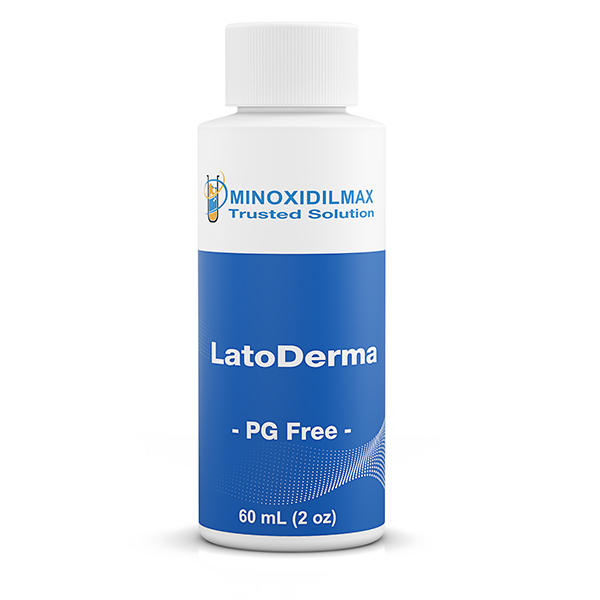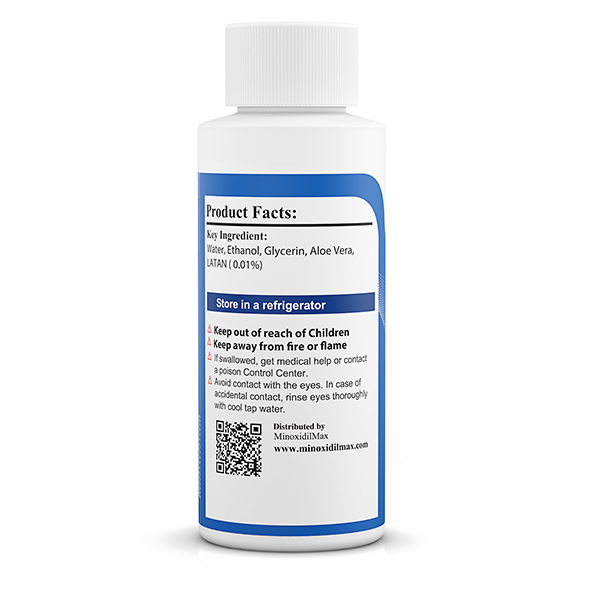Introduction
Latanoprost is a well-known medication used primarily as an eye drop to treat glaucoma and ocular hypertension. As a prostaglandin F2α analog, its main function is to reduce intraocular pressure. However, one notable side effect—enhanced eyelash growth—has sparked growing interest in its potential role in treating hair loss on the scalp.
How It Works
Latanoprost acts on FP receptors found in hair follicles. It is believed to:
-
Prolong the anagen phase, the active growth phase of hair
-
Stimulate follicles to produce thicker, longer hair
-
Convert vellus hairs (fine, light hairs) into terminal hairs (thicker, pigmented hairs)

Clinical Research
1. Androgenetic Alopecia (Pattern Baldness)
A randomized, double-blind clinical trial with 16 men suffering from early-stage male pattern baldness (Hamilton II–III) tested 0.1% latanoprost applied topically once daily. After 24 weeks, the treatment area showed a significant increase in hair density compared to placebo, without notable adverse effects.
2. Alopecia Areata (Patchy Hair Loss)
In a placebo-controlled study involving 30 patients with localized alopecia areata, 0.005% latanoprost combined with topical corticosteroids (clobetasol) led to significantly improved regrowth and hair density after 12 weeks, compared to clobetasol alone.
A larger randomized controlled trial (n=108) compared various treatment combinations. The group using betamethasone + latanoprost showed superior improvement in SALT (Severity of Alopecia Tool) scores than those using minoxidil alone.
However, in a head-to-head comparison between 0.005% latanoprost and 0.05% betamethasone monotherapy, the steroid outperformed latanoprost in terms of hair regrowth—though latanoprost had fewer side effects.
3. Eyelash and Eyebrow Loss
In a two-year study, 45% of patients with eyelash alopecia areata achieved moderate to full regrowth using nightly 0.005% latanoprost. However, another trial showed no statistically significant effect on eyelash or eyebrow growth in similar patients.
4. Animal Studies
In a study with macaques, topical latanoprost at higher concentrations (500 µg/mL) stimulated notable hair regrowth on shaved scalp areas—further suggesting that FP receptor stimulation can promote scalp hair growth.

Safety and Side Effects
Latanoprost is generally well tolerated. Side effects are usually mild and localized, such as:
-
Redness or irritation at the application site
-
Skin darkening or hyperpigmentation
-
Rarely, cystoid macular edema (when used near the eyes)
Unlike long-term corticosteroid use, latanoprost does not cause skin thinning or systemic hormonal effects, making it attractive for chronic conditions.
Current Use and Future Directions
-
Latanoprost is currently used off-label for scalp hair loss and is not FDA-approved for this purpose.
-
Some compounding pharmacies offer latanoprost in topical forms like foams or solutions.
-
Innovative approaches (e.g., nanocarrier formulations) are being explored to enhance scalp absorption.
-
Combination therapy with minoxidil or corticosteroids may improve outcomes.
Conclusion
While more large-scale studies are needed, the existing research suggests latanoprost is a safe and potentially effective treatment for certain types of hair loss, including androgenetic alopecia and alopecia areata. Its ability to stimulate hair follicles and promote regrowth, combined with its favorable safety profile, make it a promising candidate in the expanding landscape of hair restoration therapies.
Sources
-
Blume-Peytavi, U., Lönnfors, S., Hillmann, K., Garcia Bartels, N. (2012). A randomized, double-blind, placebo-controlled trial to assess the efficacy and safety of latanoprost in promoting scalp hair growth in subjects with androgenetic alopecia. British Journal of Dermatology, 167(4), 794–797.
-
Dinh, Q.Q., Sinclair, R. (2007). Female pattern hair loss: Current treatment concepts. Clinical Interventions in Aging, 2(2), 189–199.
-
Kassira, S., Korta, D.Z., Chapman, L.W., Dann, F.J. (2017). Latanoprost for treatment of eyelash and eyebrow alopecia. Journal of Drugs in Dermatology, 16(7), 685–689.
-
Siah, T.W., Tosti, A., Piraccini, B.M. (2020). Topical prostaglandin analogues in alopecia: a review. Dermatologic Therapy, 33(6), e13961.
-
Khattab, A., El-Domyati, M., Fawzy, M.M., Nasif, G.A. (2020). Topical latanoprost in alopecia areata: a randomized controlled trial. Clinical, Cosmetic and Investigational Dermatology, 13, 143–151.
-
Uno, H., Kurata, S., Yamada, K. (2002). Prostaglandin analogs and hair growth in the bald scalp of the stump-tailed macaque. Journal of Dermatological Science, 28(1), 68–75.
-
Ghassemi, M., Nasimi, M., Arzhanga, P., et al. (2021). Comparison of latanoprost and betamethasone in the treatment of localized alopecia areata: A double-blind randomized clinical trial. Journal of Cosmetic Dermatology, 20(2), 495–500.










